Many Americans hit the road on vacation each year. In an effort to cut down the number of accidents due to not knowing or understanding road signs, this tip is dedicated to everyone who drives U.S. highways.
ON A PERSONAL NOTE: This tip is also dedicated to my brother Melvyn Seid who passed away in May 2009. He was a man who loved traveling the world and often took his family on fun road trips all around the United States in their family van.
_____________________
Road signs and other highway markings are the driver’s guide to road safety. Knowing what these signs mean and using them and other rules of the road properly makes life easier for you and more pleasant for all the drivers and pedestrians you encounter. So how you drive is an important part of etiquette.
How well do you know road etiquette? Answer the following seven questions after reading each description of the situation:
QUESTION 1: You’re driving on a freeway, nearing a large city and the convergence of several highways. Your road goes from two lanes to three, four, and then five, and tr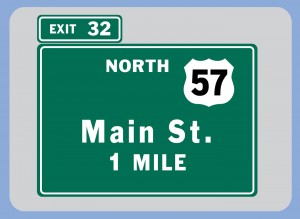 affic is getting heavy. A large green sign for your exit shows, “North US 57, Main Street 1 mile” with a small sign on the top-left reading “EXIT 32.” What must you do to exit as safely and quickly as possible?
affic is getting heavy. A large green sign for your exit shows, “North US 57, Main Street 1 mile” with a small sign on the top-left reading “EXIT 32.” What must you do to exit as safely and quickly as possible?
A. Ask passengers to keep a lookout for your off-ramp so you can get into the appropriate lane to exit.
B. Stay in the right lane so you are ready to exit.
C. Move to the far left lane to be ready to exit.
D. Move to the middle lane so you can move to your exit quickly when you see it.
ANSWER: The small exit number sign on top of a larger directional sign is always on the same side as the exit. Since the “EXIT 32” sign is on the top-left of the big sign, your exit ramp is on the left. Therefore, “C” is correct.
QUESTION 2: While driving cross-country, you enter Interstate Highway I-23 at “EXIT 42” and get off at “EXIT 163.” In what direction are you driving and how far have you traveled?
B. North, 121 miles
C. South, 121 miles
D. West, 205 miles
ANSWER: Almost all Interstate and US highways and some State highways going north and south are numbered in odd numbers. Those going east and west are numbered in even numbers. Most states follow federal guidelines and number their exits according to the mile markers. On even-numbered highways they begin in the west and increase as you drive east. Odd-numbered highways begin in the south and increase driving north.
Therefore, “B” is the correct answer. Because the number increases, it indicates you are driving north, for 121 miles (163 – 42 = 121).
Note: To my knowledge, the State of New York numbers its exits consecutively west to east and south to north without any regard to the mile markers. California historically did not display exit numbers and mile markers until recently; they are appearing more and more in certain sections of the state. These are the only exceptions. If you know of other exceptions, please let us hear from you.
QUESTION 3: Driving at night on a rural road with no streetlights, your headlights are the only illumination. A sign appears ahead of you, a tall rectangle with alternating black and yellow stripes slanting down to the left. Without looking at the road’s edge stripes or anything else, this sign indicates you should immediately: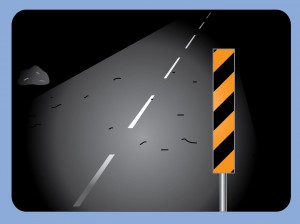
A. Stop! The road is about to end.
B. Drive cautiously around the sign on either side and watch for an obstruction.
C. Drive to the left of the sign and continue.
D. Drive to the right of the sign and continue.
ANSWER: This sign is an object marker. It warns of an obstruction, such as a bridge abutment or other intrusion into the roadway. The slanted lines always point down toward the lane and direction in which it is safe to avoid the obstruction. Therefore, “C” is correct.
Similar signs and barriers with slanted lines guide you around construction zones and other hazards or obstructions. Always note the direction in which the lines slant down and go around the barrier to that side.
QUESTION 4: You are entering a freeway on the on-ramp, driving in unfamiliar territory. You notice a continuous white line on your left and a solid yellow line on the right. Without 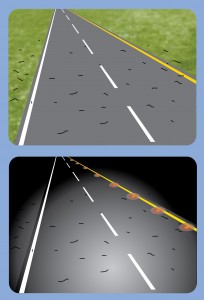 hesitation, you should:
hesitation, you should:
A. Proceed cautiously onto the highway.
B. Cross the line quickly into the next lane.
C. Accelerate to highway speed.
D. Back up immediately!
ANSWER: Oops! Yellow stripes separate traffic traveling in opposite directions or mark the left edge of the highway. If you ever see a yellow line on your right, you are going the wrong way into opposing traffic. White edge lines always define the right edge of the road. In this case you have turned onto an exit ramp. Stop and back down the ramp immediately. Therefore, “D” is correct.
All roads conform to this rule. In many cases there are red reflectors on the yellow line, which you see in the headlights of cars going the wrong way, in case the yellow line is not readily visible at dusk or at night.
QUESTION 5: You are driving on a six-lane highway with three lanes on your side. You are in lane Number 3, the far right lane, and you want to pass the slow trucks and cars that are using the lane as well. Cars in the other two lanes are moving faster and passing the slower cars and trucks. You should:
A. Carefully move into lane 2 to pass one or more of the slower vehicles.
B. Move into lane 1 if the vehicles in the middle and right lane are slower than you and you want to pass.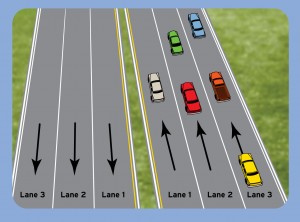
C. Move into the Number 1 lane and stay there to be sure you are never impeded by slower traffic.
D. Drive in whatever lane is comfortable, because faster traffic will go around you.
E. Always drive in lane 2 when there are three lanes, so you have room to maneuver.
ANSWER: “A,” “B” or “E”‘ are correct. I hope you did not choose “C.” This is my biggest pet peeve, when drivers remain in the far left Number 1 lane, no matter what. Driving etiquette says you only use the left lane as a passing lane, except when all lanes are full of traffic.
If you want to pass, do so to the left. If you are passing and a faster car comes up behind you, do not continue to block that car. Slow down and move into a lane to your right until the car passes you. In other words, do not hog the fast lane whenever cars are behind you. If you chose “D,” this could be you.
Especially at night, if you come upon a slow vehicle and want to pass, do not immediately go around it to the right. Flash your headlights or flick your high beams on and off to let the driver know you want to pass. If the car doesn’t move over in a reasonable time, then signal a lane change and move around the car.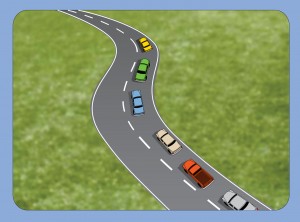
When changing lanes for any reason, use your turn signals so all the drivers around you know your intention. Surprising other drivers with unannounced lane changes can cause accidents.
QUESTION 6: You are driving on a two-lane winding road either at the speed limit or a little slower, so you can enjoy the scenery. Four cars and a truck are piled up behind you. You should:
A. Continue driving. When you get to a road with more lanes or a passing lane, cars can get around you.
B. Speed up to the limit or faster so you can leave cars behind.
C. When it is safe, pull over into a turnout or wide shoulder to let cars pass, then resume your journey.
D. Slow down even more to give the more adventurous drivers a chance to pass you on straighter stretches of the road or when they can see no cars coming the other way.
ANSWER: It’s the law! When four or more cars pile up behind you on any road because you are going slower than others may want–even if you are driving at or over the speed limit–you must pull into a turn-out or onto a safe shoulder to let them pass. Therefore, “C” is correct.
When you see another car behind you on a one-lane road, the courteous thing to do is drive at least as fast as the limit until you reach a place to safely let the other car(s) pass. Causing other drivers to get frustrated or angry because you are holding them up, often causes them to do dangerous things–such as pass you when it is not safe on curves or when cars are coming the other way. Some may try to pass you on the shoulder which is not only unsafe, it’s also illegal.
QUESTION 7: You’re renting a car and it’s time to fill it with gas. You realize you have not noticed on which side the gas tank is located. To find out, you should: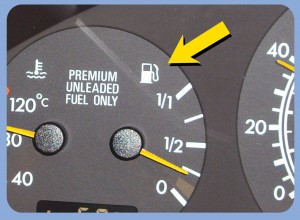
A. Pull into a gas station and don’t worry about it. If it’s on the wrong side, the hose will stretch
B. Look at the dashboard for a gas pump icon
C. Have your wife or child hang out a window and look
D. Look at your car’s reflection in a store window as you drive by to see it
ANSWER: Choose “B.” If there is an icon of a gas pump, the side on which the hose is shown indicates which side of the car your gas tank is located. Check it out on your own car. It should be consistent. If not, let us hear what make and model you have.
I hope this tip has been fun for you to check out a little of your EIQ (Etiquette Intelligence Quotient) with regards to road sign etiquette.
Question: What other road signs do you have to add to this list readers should know about that are not as commonplace? Do let us hear from you by locating this article at www.AdvancedEtiquette.com/blog. You may also reach us at www.AdvancedEtiquette.com. If you enjoyed this article and want more, subscribe to our “Etiquette Tip of the Month” newsletter—at no charge—filled with great monthly tips on all sorts of topics from international business and social etiquette and protocol to everyday life subjects. It will be great to have you as a member of our happy family of subscribers at www.AdvancedEtiquette.com/subscribe.
Happy Driving!

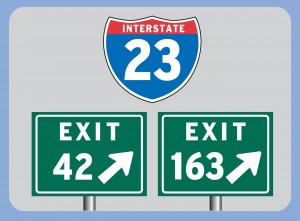
This page has at least two photos where the hose on the gas pump symbol is on the opposite side of where the fuel door arrow is pointing. Perhaps the hose is used as an indicator when no arrow is present?
http://vehicle-maintenance.wonderhowto.com/how-to/what-side-your-car-is-gas-tank-on-easy-trick-will-tell-you-every-time-0143695/
I am an ESL teacher and I just want to tell you that I think your website is magnificent in every way! I am so happy to have discovered it. I will recommend it to all my students in my Conversation Club. Great work!
Brenda: Thank you for your post. It is always appreciated to hear when readers enjoy what they are reading from us. Please have all your students subscribe to the newsletter in the upper right corner. We’d enjoy having them.
I drive a 1996 Cadillac Eldorado with the fuel tank on the driver’s side and the hose on the fuel pump icon on the right. I’ve yet to see a newer car that defies the convention mentioned in your article though.
Ryan: You are probably correct. The article was written way back when it was true, yet might not be today. I’ll try to check into this to hopefully let everyone know. Thanks for taking a moment to write.
Hola: Muchas Gracias!
Great Post! Thank you for sharing useful information.
Question 7 is inaccurate. The icon is only useful for indicating the side of vehicle if there is an additional arrow indicating left or right. The icon itself ALWAYS shows the hose on the right, regardless of the side of car the fuel door is on.
Arrows next to that icon became common around the turn of the century.